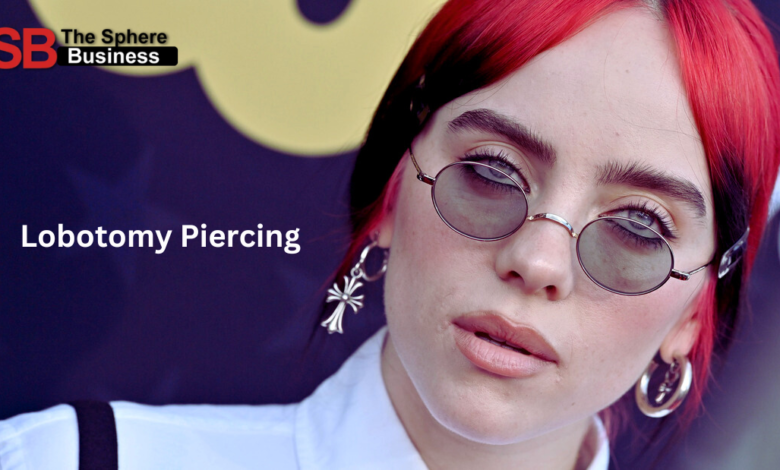Lobotomy Piercing: An In-Depth Look at a Controversial Trend

In the world of body modification, new and sometimes shocking trends emerge regularly. One such trend that has caused both fascination and outrage is the “lobotomy piercing.” While the name may conjure up disturbing images of medical procedures, the reality of this piercing is quite different. It is a unique form of body modification that has attracted attention for its boldness and its roots in countercultural aesthetics. In this article, we’ll take a closer look at the lobotomy piercing—what it is, how it’s done, its origins, and the controversies surrounding it.
What is a Lobotomy Piercing?
The lobotomy piercing is a relatively new addition to the world of body modification, but it has gained significant attention due to its name, appearance, and the cultural connotations it evokes. A lobotomy piercing is a surface piercing, typically placed on the forehead, above the eyes. It involves creating a small hole in the skin and inserting a barbell or other form of jewelry through it.
Unlike traditional piercings that go through the skin and into the tissue underneath (such as earlobe piercings or nose piercings), surface piercings are placed in a way that the jewelry lies just beneath the top layer of the skin. This makes them prone to migration or rejection over time, which can lead to complications such as scarring or infection.
One defining characteristic of the lobotomy piercing is that it is positioned in a way that suggests a connection to the medical procedure for which it is named. The piercing is typically placed in the area where a lobotomy incision might have been made—near the forehead, where medical professionals once drilled holes in the skull to perform the controversial and now outdated procedure.
The History of Lobotomies and Their Connection to the Piercing
To fully understand the significance of the term “lobotomy piercing,” it’s essential to have a basic understanding of what a lobotomy was and how it became a part of medical history. A lobotomy is a type of brain surgery that was popular from the 1930s through the 1950s as a treatment for mental illnesses such as depression, anxiety, and schizophrenia.
The procedure involved cutting or scraping away parts of the frontal lobes of the brain, which were believed to be the cause of mental disorders. The lobotomy was performed by drilling holes into the skull or inserting instruments through the eye sockets to sever neural pathways in the brain. This often resulted in severe personality changes, cognitive impairment, and even death in some cases. It was later largely discredited as both inhumane and ineffective.
The connection between the lobotomy piercing and the medical procedure lies in the symbolic and aesthetic relationship to the idea of “cutting into the mind” or “altering the brain.” While the piercing does not have any direct medical function, its name and placement above the forehead can be seen as a provocative commentary on the lobotomy’s legacy. For body modification enthusiasts, the piercing could represent a rebellion against the traditional medical establishment or a form of expression through dark, countercultural art.
How is a Lobotomy Piercing Done?
Getting a lobotomy piercing typically involves a skilled professional piercer who is experienced with surface piercings. It is not a procedure to be taken lightly, as surface piercings have a higher risk of rejection compared to traditional piercings. Here’s an overview of the steps involved in the process:
1. Consultation
Before undergoing the piercing, a consultation is essential. During this phase, the piercer will discuss the procedure with the client, assess the placement, and explain the potential risks, including the possibility of migration or rejection of the piercing. The client should be prepared to ask questions and provide details about their medical history, such as any allergies or existing skin conditions that could complicate the process.
2. Marking the Area
Once both the client and the piercer have agreed on the placement, the area is marked with a sterile pen or marker. This ensures the piercer knows exactly where to make the incision.
3. Piercing
Using a sterilized needle, the piercer will create a hole in the skin. For a lobotomy piercing, the hole is typically made just above the eyes, centered on the forehead. After the hole is made, a small barbell or surface bar is inserted through the hole. The jewelry used is usually a titanium or surgical steel bar, which reduces the risk of infection and ensures a better healing process.
4. Aftercare
After the piercing is done, proper aftercare is critical to prevent complications such as infection or rejection. The client must follow the aftercare instructions provided by the piercer, which often include cleaning the area with saline solution, avoiding touching the piercing with dirty hands, and avoiding tight clothing or hats that could rub against the piercing.
Because surface piercings are more likely to migrate or become irritated, the healing process can take several months. Clients should be prepared for possible discomfort and should monitor the piercing for any signs of rejection, including swelling, redness, or the jewelry moving beneath the skin.
The Controversy Surrounding the Lobotomy Piercing
Like many forms of body modification, the lobotomy piercing has attracted both admiration and criticism. Here are some of the main points of contention:
1. The Name: Insensitive or Provocative?
One of the biggest criticisms of the lobotomy piercing is its name. For many people, the term “lobotomy” carries significant historical weight. It evokes a time when mental health patients were subjected to brutal and dehumanizing procedures in the name of treatment. Critics argue that naming a piercing after such a controversial and painful procedure is insensitive, particularly to those who have suffered from mental illness or those who lived through the era of lobotomy treatments.
On the other hand, some body modification enthusiasts argue that the name is intentionally provocative and designed to spark conversation. For them, the piercing is not meant to be disrespectful but to make a statement about personal autonomy, rebellion against societal norms, and the questioning of traditional medical practices.
2. Risk of Rejection and Complications
Surface piercings, including the lobotomy piercing, have a higher risk of rejection than other types of piercings. Rejection occurs when the body treats the jewelry as a foreign object and pushes it out of the skin. This can lead to scarring, infection, or the need for the piercing to be removed. Given the placement of the lobotomy piercing on the forehead, it can also interfere with facial expressions, cause discomfort, or lead to accidental bumps or snags.

3. Aesthetic Value and Personal Expression
For many individuals, body modifications such as the lobotomy piercing are a way of expressing their identity and beliefs. The aesthetic appeal of the piercing lies in its uniqueness and its ability to stand out from more traditional forms of body art. It serves as a personal statement for those who choose to wear it, symbolizing nonconformity or a desire to break from societal norms.
Is the Lobotomy Piercing Right for You?
If you’re considering a lobotomy piercing, there are several factors to take into account:
- Pain and healing: The procedure itself may not be overly painful, but surface piercings often take longer to heal and are more prone to complications.
- Risk of rejection: Surface piercings are more likely to be rejected by the body than other types of piercings, which could lead to scarring or the need for the jewelry to be removed.
- Aesthetic appeal: The piercing is certainly a bold fashion statement and is best suited for individuals who are drawn to alternative forms of self-expression.
Conclusion: A Bold Statement of Individuality
The lobotomy piercing is a striking and controversial form of body modification that blends elements of medical history, countercultural rebellion, and personal expression. Its name, placement, and aesthetic appeal challenge traditional norms and provoke thought about the relationship between body and mind. While it may not be for everyone, the lobotomy piercing represents an extreme form of individuality for those who embrace it, making it an unforgettable trend in the world of body art and modification.
However, before deciding to get this piercing, it’s crucial to carefully consider the risks and understand the significance of its name. Ultimately, the decision is a personal one that reflects an individual’s desire for self-expression and willingness to challenge conventional boundaries.





